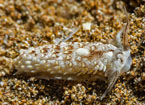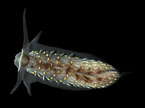| Home |
| Acknowledgments |
| Conventions |
| Glossary |
| Maps |
| References |
| Links |
| Articles |
| Thumbnails |
| Species
list |
| Family |
| Next
species |
Additional Photos

side

underside

white flecks

yellow bars

young

fluorescence

burrowing

feeding

egg mass

Cerberilla sp. #1

| Maximum size: 15 mm. Identification: This is a translucent-cream animal with long cephalic tentacles and a broad foot. The cerata are stained with brown and have narrow, yellow medial bands. The head has dark brown bands and a patch of yellow between the cephalic tentacles. Unlike in Cerberilla albopunctata, the rhinophores remain light at all sizes, the cephalic tentacles and sides lack well-defined white spots (though there may be a few white flecks on the cephalic tentacles), yellow bars in front of the rhinophores are absent (or faint), posterior cerata lack brown tips and there are yellow bands on all or most of the ventral cerata. Though older animals may develop some mottling on the notum, it's far less extensive than in C. albopunctata and the center of the notum is largely obscured by cerata, anteriorly. (Note 1) Natural history: Unlike most Cerberilla spp., Cerberilla sp. #1 appears to be a nocturnal feeder. We've observed it on a number of occasions foraging at night in holding dishes with its cephalic tentacles extended to the side. It buried itself in sand in the bottom of the dishes during the day. We have also seen it actively crawling in the field at night. However, others have seen numerous animals crawling in the open by day suggesting that it also feeds (or mates?), then. (Note 2) It's a moderately common species that can be found in protected, back-reef sand patches at depths of about 1 m (3 ft) as well as in Halimeda kanaloana beds at depths of 6-11 m (20-36 ft). It feeds on a small ceriantharian anemone (probably Arachnanthus sp.) and lays a white, corkscrew-shaped egg mass that is anchored in sand. (Note 3) The eggs hatch in about five days in the laboratory. Distribution: Big Island and Maui: may also be known from French Polynesia. Taxonomic notes: It was first recorded in Hawaii from Hekili Point, Maui by CP on Nov. 1, 1997. Photo: CP: Hekili Point, Maui; Nov. 19, 2002. Observations and comments: Note 1: The yellow pigment on the head and cerata shows strong green fluoresces under UV light. (see photo) Since this species is nocturnally active, the florescence might contribute to its pattern of camouflage under specific conditions (strong moonlight? dusk/dawn?) Or, it might be a neutral characteristic that is coincident to a pigment deposited for some other reason... Note 2: Rebecca Bicker reported seeing numerous animals crawling on open sand during the day at Maalaea Bay. Kevin Roe, Mike Ryan and others have also seen them at the site. Perhaps, there is something unique to the area that favors diurnal activity? Or, perhaps the daytime sightings represent a mating aggregation? Most animals photographed by day were in all ways comparable to those seen at night. Note 3: Katherine Shepherd observed one feeding on a small ceriantharian anemone. She reported that "The slug, at first, recoiled from touching the anemone, but then quickly attacked! It eventually disappeared down the tube." Since Katherine observed it completely disappearing down the anemone's tube following the attack, perhaps it more fully consumes it than "one bite and move on" predators like Dermatobranchus rubidus? (see photos) |
| Thumbnails |
Species
list |
Family | Next species | Top |